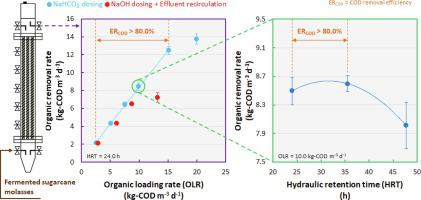Energy Conversion and Management ( IF 9.9 ) Pub Date : 2021-05-02 , DOI: 10.1016/j.enconman.2021.114203 Lucas Tadeu Fuess , Marcelo Zaiat , Claudio Augusto Oller do Nascimento

|
Energetic exploitation of sugarcane-derived byproducts via anaerobic digestion (AD) has recently been highlighted as an alternative to the conventional ethanol-producing approach. In this context, the thermophilic (55 °C) methane production from fermented molasses was assessed in the long-term (>200 d) continuous operation of two anaerobic structured-bed reactors. Two types of alkalinization strategies, namely, NaHCO3 dosing (RM1) and NaOH dosing coupled to effluent recirculation (RM2) were compared, as well as different levels of organic loading rate (OLR) and hydraulic retention time (HRT) were applied to reach limiting operating conditions. Both alkalinization strategies provided an equivalent buffer control up to an OLR of 7.5 kg-CODt m−3 d−1, from which unwanted accumulation of organic acids was observed in RM2. NaHCO3 dosing enabled doubling the OLR (15.0 kg-CODt m−3 d−1) without performance deterioration, i.e., organic matter removal > 80.0% and maximum methane yield values. A detailed assessment of the food-to-microorganism ratio demonstrated the maintenance of stable operating conditions at excess substrate availability (>3.0 g-CODt g−1VSS d−1) in the feeding chamber (FDC) of the reactors, in which substrate conversion exceeded 70.0%. Organic overloads occurred only when biomass retention reached a saturation level in the FDC, hampering the uptake of volatile organic acids, regardless of the operating condition. In any case, the wide range of operating conditions (OLR = 2.5–15.0 kg-CODt m−3 d−1 and HRT = 24.0–36.0 h) associated with maximized methane production characterized a highly flexible process, which enables varied design arrangements in full-scale AD plants.
中文翻译:

高速结构床反应器中发酵甘蔗糖蜜的嗜热生物消化:碱化策略定义了操作极限
近来,人们强调了通过厌氧消化(AD)大力开发甘蔗衍生的副产物,作为常规乙醇生产方法的替代方法。在这种情况下,在两个厌氧结构化床反应器的长期(> 200 d)连续运行中评估了发酵糖蜜产生的嗜热甲烷(55°C)。比较了两种碱化策略,分别是NaHCO 3配量(RM1)和NaOH配量与废水再循环(RM2),以及应用了不同水平的有机负荷率(OLR)和水力停留时间(HRT)限制运行条件。两种碱化策略均提供了等效的缓冲液控制,最高OLR为7.5 kg-CODt m -3 d -1,从中可观察到RM2中有害的有机酸积累。NaHCO 3的添加使OLR倍增(15.0 kg-CODt m -3 d -1)而不会降低性能,即有机物去除率> 80.0%和最大甲烷产率值。对食物与微生物比率的详细评估表明,在过量的底物利用率(> 3.0 g-CODt g -1 VSS d -1时,可以保持稳定的操作条件))在反应器的进料室(FDC)中,其中底物转化率超过70.0%。仅在FDC中生物量保留达到饱和水平时,才发生有机过载,而无论操作条件如何,都会阻碍挥发性有机酸的吸收。在任何情况下,与最大的甲烷生产量相关的宽范围的运行条件(OLR = 2.5–15.0 kg-CODt m -3 d -1和HRT = 24.0–36.0 h)具有高度灵活的过程,可实现多种设计方案全面的AD工厂。











































 京公网安备 11010802027423号
京公网安备 11010802027423号